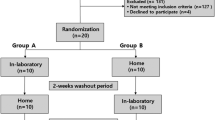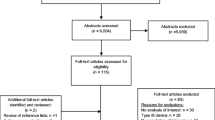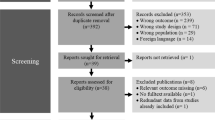Abstract
Purpose
To evaluate the differences in reliability and costs of home respiratory polygraphy (HRP) when installed by the patient and by a nurse, in order to determine the factors affecting and to consider the possible generalization of self-setup procedure. Several HRP devices have been validated for obstructive sleep apnea (OSA) diagnosis but convenience of a nurse intervention in HRP installation has been scarcely studied.
Methods
This is a prospective and interventional study. About 301 participants were assigned to 2 groups: self-setup and nurse intervention. Sleep study, questionnaires, and diagnostic procedures were performed following the clinical practice in 2016. Signals were considered lost above 3 min, and success of the test was established according to guidelines. Costs were calculated according to a previous multicenter study.
Results
Both groups (self-setup and nurse intervention) resulted homogeneous in age, gender, BMI, and final diagnosis of OSA. Signal losses during the test were similar in both groups. Slightly higher percentage of unsuccessful tests were obtained in the self-setup procedure (5.3 vs 2.0%, p = 0.121). The costs were similar (107 vs 105 €) in the self-setup group as compared to the nurse setup group.
Conclusions
The setup of HRP by either the patient or nurse had similar costs and data acquisition. Both installation procedures of HRP were similar regarding test reliability and costs. Main findings are that self-installation by the patient could be similarly reliable and economic as installation by a nurse, as far as consensus guidelines are followed. This study demonstrates that self-setup of HRP is a potentially viable option for the diagnosis of OSA.


Similar content being viewed by others
References
Punjabi NM (2008) The epidemiology of adult obstructive sleep apnea. Proc Am Thorac Soc 5:136–143
Peppard PE, Young T, Barnet JH, Palta M, Hagen EW, Hla KM (2013) Increased prevalence of sleep-disordered breathing in adults. Am J Epidemiol 177(9):1006–1014
Duran J, Esnaola S, Rubio R, Iztueta A (2001) Obstructive sleep apnoea-hypopnea and related clinical features in a population-based sample of subjects aged 30 to 70 yr. Am J Respir Crit Care Med 163:685–689
Marshall NS, Wong KKH, Cullen SRJ, Knuiman MW, Grunstein RR (2014) Sleep apnea and 20-year follow-up for all-cause mortality, stroke, and cancer incidence and mortality in the Busselton health study cohort. J Clin Sleep Med 10(4):355–362
Martinez-Garcia A, Campos-Rodriguez F, Duran-Cantolla J (2014) Spanish Sleep Network. Obstructive sleep apnea is associated with cancer mortality in younger patients. Sleep Med 15(7):742–748
Gonzaga C, Bertolami A, Bertolami M, Amodeo C, Calhoun D (2015) Obstructive sleep apnea, hypertension and cardiovascular diseases. J Hum Hypertens 29(12):705–712
Terán-Santos J, Jimenez-Gomez A, Cordero-Guevara J, & Cooperative Group Burgos-Santander (1999) The association between sleep apnea and the risk of traffic accidents. N Engl J Med 340:847–851
Masa JF, Corral J, Pereira R, Duran-Cantolla J, Cabello M, Hernández-Blasco L, Monasterio C, Alonso A, Chiner E, Rubio M, Garcia-Ledesma E, Cacelo L, Carpizo R, Sacristan L, Salord N, Carrera M, Sancho-Chust JN, Embid C, Vázquez-Polo FJ, Negrín MA, Montserrat JM (2011) Effectiveness of home respiratory polygraphy for the diagnosis of sleep apnoea and hypopnoea syndrome. Thorax 66:567–573
Alonso-Alvarez ML, Terán-Santos J, Cordero-Guevara J, González Martínez M, Rodríguez Pascual L, Viejo Bañuelos JL, Marañón CA (2008) Reliability of home respiratory polygraphy for the diagnosis of sleep apnea-hypopnea syndrome: analysis of costs. Arch Bronconeumol 44:22–28
Alonso-Alvarez ML, Navazo-Eguia AI, Cordero-Guevara JA, Ordax-Carbajo E, de la Mata G, Barba-Cemeño JL, Terán-Santos J (2012) Respiratory polygraphy for follow-up of obstructive sleep apnea in children. Sleep Med 13(6):611–615
Alonso-Alvarez ML, Teran-Santos J, Ordax Carbajo E, Cordero-Guevara JA, Navazo-Egüia AI, Kheirandish-Gozal L, Gozal D (2015) Reliability of home respiratory polygraphy for the diagnosis of sleep apnea in children. Chest 147(4):1020–1028
Andreu AL, Chiner E, Signes-Costa J, Gómez-Merino E, Pastor E, Arriero JM, Llombart M, & Marco J. (2004). Validez diagnóstica y reproducibilidad de la poligrafía respiratoria practicada en el hospital y en el domicilio. Archivos de Bronconeumología, 40 Supl 2:65
Núñez Cayama R, Socarras Busot E, Calleja Pascual JM, Alvarez Ruiz de Larrinaga A, Rey de Castro J, Aizpuru Barandiaran F, Rubio Aramendi R, Durán Cantolla J (2004) Comparación de la validez diagnóstica entre uso hospitalario y domiciliario del Polígrafo Respiratorio (PR) (BREAS SC 20) para el diagnóstico de pacientes con sospecha clínica de síndrome de apneas e hipopneas durante el sueño (SAHS). Arch Bronconeumol 40(Supl 2):51
Socarras Busot E, Núñez Cayama R, Calleja Pascual JM, Alvarez Ruiz de Larrinaga A, Aizpuru Barandiaran F, Rubio Aramendi R, Durán Cantolla J (2004) Validez del polígrafo respiratorio (PR) Embletta para el diagnóstico de pacientes con sospecha clínica de síndrome de apneas e hipopneas del sueño (SAHS). Comparación entre uso hospitalario y domiciliario. Archivos de Bronconeumología 40(Supl 2):–60
Corral J, Sánchez-Quiroga MA, Carmona-Bernal C, Sánchez-Armengol A, Sánchez de la Torre A, Durán-Cantolla J, Egea CJ, Salord N, Monasterio C, Terán J, Alonso-Alvarez ML, Muñoz-Mendez J, Arias EM, Cabello M, Montserrat JM, Peña M, Serrano JC, Barbé F, Masa F, Network SS (2017) Conventional polysomnography is not necessary for the management of most patients with suspected obstructive sleep apnea. Noninferiority. Randomized Controlled Trial American Journal of Respiratory and Critical Care Medicine 196(9):1181–1190
Jurado Gámez B, Redel Montero J, Muñoz Cabrera L, Fernández Marín MC, Muñoz Gomáriz E, Martín Pérez MA, Cosano PA (2007) Cost–effectiveness and degree of satisfaction with home sleep monitoring in patients with symptoms of sleep apnea. Arch Bronconeumol 43(11):605–610
Masa JF, Corral J, Gomez de Terreros J, Duran-Cantolla J, Cabello M, Hernández-Blasco L, Monasterio C, Alonso A, Chiner E, Aizpuru F, Zamorano J, Cano R, Montserrat JM, Collaborating group (2013) Significance of including a surrogate arousal for sleep apnea-hypopnea syndrome diagnosis by respiratory polygraphy. Sleep 36(2):249–257
Domingo C, Vigil L (2011) Effectiveness of unattended ambulatory sleep studies for the diagnosis and treatment of OSAS. J Eval Clin Pract 17(1):26–31
García-Díaz E, Quintana-Gallego E, Ruiz A, Carmona-Bernal C, Sánchez-Armengol Á, Botebol-Benhamou G, Capote F (2007) Respiratory polygraphy with actigraphy in the diagnosis of sleep apnea-hypopnea syndrome. Chest 131(3):725–732
Golpe R, Jiménez A, Carpizo R (2002) Home sleep studies in the assessment of sleep apnea/hypopnea syndrome. Chest 122(4):1156–1161
Alonso-Álvarez ML, Canet T, Cubel- Alarco M, Estivill E, Fernandez-Julian E, Gozal D, Jurado-Luqué MJ, Lluch-Roselló A, Martínez-Pérez F, Merino-Andreu M, Pin-Arboledas G, Roure N, Sanmartí F, Sans-Capdevila O, Segarra-Isern F, Tomás-Vila M, Terán-Santos J (2011) Documento de Consenso del Síndrome de Apneas Hipopneas durante el sueño en niños. Arch Bronconeumol 47(Suppl 5):1–18
Iber C, Ancoli-Israel S, Chesson A et al (2007) AASM manual for the scoring of sleep and associated events: rules, terminology and technical specifications, 1st edn. American Academy of Sleep Medicine, Westchester
Collop NA, Anderson WM, Boehlecke B, Claman D, Goldberg R, Gottlieb DJ, Hudgel D, Sateia M, Schwab R (2007) Clinical guidelines for the use of unattended portable monitors in the diagnosis of obstructive sleep apnea in adult patients. Portable Monitoring Task Force of the American Academy of Sleep Medicine. J Clin Sleep Med 3(7):737–747
Chiner E, Arriero JM, Signes-Costa J, Marco J, Fuentes I (1999) Validation of the Spanish version of the Epworth Sleepiness Scale in patients with a sleep apnea síndrome. Arch Bronconeumol 35:422–427
Aurora RN, Putcha N, Swartz R, Punjabi NM (2016) Agreement between results of home sleep testing for obstructive sleep apnea with and without a sleep specialist. Am J Med 129:725–730
Bruyneel M, Libert W, Ameye L, Ninane V (2015) Comparison between home and hospital set-up for unattended home-based polysomnography: a prospective randomized study. Sleep Med 16(11):1434–1438
Miller JN, Schulz P, Pozehl B, Fiedler D, Fial A, Berger AM (2018) Methodological strategies in using home sleep apnea testing in research and practice. Sleep Breath 22(3):569–577
Funding
This study was funded by Fundación Burgos por la Investigación de la Salud N° 1615.
Author information
Authors and Affiliations
Corresponding author
Ethics declarations
All procedures performed in studies involving human participants were in accordance with the ethical standards of the institutional and/or national research committee and with the 1964 Helsinki declaration and its later amendments or comparable ethical standards. Informed consent was obtained from all individual participants included in the study.
Conflict of interest
The authors declare that they have no conflict of interest.
Additional information
Publisher’s note
Springer Nature remains neutral with regard to jurisdictional claims in published maps and institutional affiliations.
Rights and permissions
About this article
Cite this article
Barriuso, B., Martin, L., Sevilla, C. et al. Self-setup of home respiratory polygraphy for the diagnosis of sleep apnea syndrome: cost-efficiency study. Sleep Breath 24, 1067–1074 (2020). https://doi.org/10.1007/s11325-019-01959-4
Received:
Revised:
Accepted:
Published:
Issue Date:
DOI: https://doi.org/10.1007/s11325-019-01959-4




